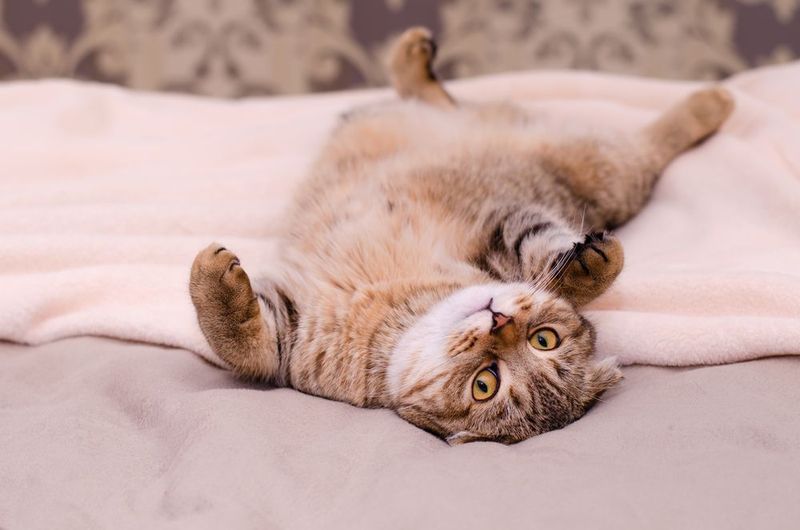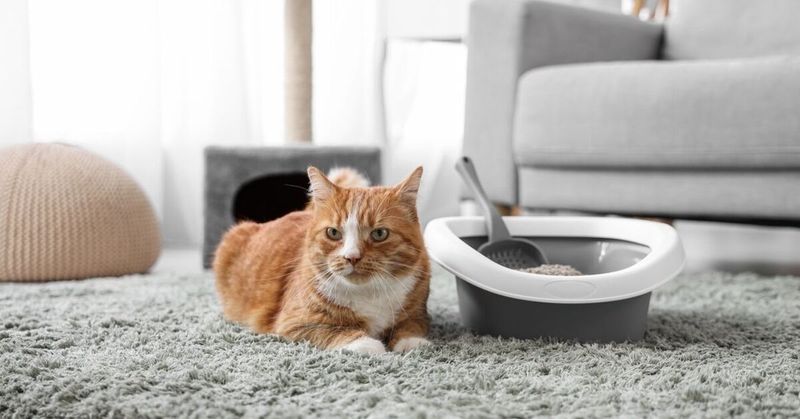📖 Table of Content:
Cats experience the world in ways that don’t always align with human habits. What seems harmless or routine to people can be deeply unsettling or annoying to a feline. These misunderstandings often go unnoticed, leaving cats quietly uncomfortable.
While they may not protest loudly, cats have clear boundaries and preferences. Ignoring these signals can lead to tension, avoidance, or even behavioral issues over time. Paying attention to their subtle cues helps build mutual trust and respect.
Learning what behaviors cats secretly dislike allows for smoother, more affectionate relationships. Small changes in daily routines can make a big difference in how secure and content a cat feels. A more cat-friendly approach often results in a happier, more engaged companion.
1. Forced Belly Rubs
Most cats view their soft, fluffy bellies as protected zones, not invitation mats for human hands. When your cat rolls over, they’re actually showing trust by exposing their most vulnerable area – not necessarily asking for a tummy tickle.
Touch receptors in a cat’s belly are extremely sensitive, and many felines instinctively protect this area from potential threats. That’s why your innocent belly rub often triggers the famous grab-scratch-bite combo that leaves you wondering what went wrong.
Try focusing on safer petting zones like behind the ears, under the chin, or along the back instead. Your cat will appreciate your respect for their personal boundaries.
2. Staring Contests
Direct eye contact means something completely different in cat language than it does to humans. While we see it as attention or affection, your cat interprets prolonged staring as a threat or challenge.
Cats naturally avoid direct eye contact with creatures they don’t want to fight. When you lock eyes with your feline friend, their stress hormones might spike as they wonder why you’re suddenly challenging their position in the household hierarchy.
Instead of staring, try the slow blink technique – gently closing your eyes and opening them when around your cat. This “cat kiss” communicates safety and affection in a language they understand perfectly.
3. Loud Music and Sudden Noises
Cats possess hearing abilities far superior to humans – they can detect sounds at frequencies up to 64,000 Hz compared to our measly 20,000 Hz. Your “normal volume” music might feel like a rock concert happening inside their sensitive ears.
Sudden loud noises trigger your cat’s fight-or-flight response, flooding their system with stress hormones. This explains why many cats bolt from the room when you turn on the vacuum cleaner or crank up your favorite song.
Create a cat-friendly sound environment by maintaining moderate volume levels and providing quiet retreat spaces. Your cat will thank you by sticking around instead of hiding under the bed for hours.
4. Ignoring Litter Box Cleanliness
With their instinct for cleanliness, cats treat hygiene like a personal code. A dirty litter box is more than unpleasant—it’s the feline equivalent of being forced into a bathroom that hasn’t been flushed in days.
When you neglect regular scooping, your fastidious feline feels stressed and may protest by finding alternative bathroom spots around your home. Their sensitive noses detect ammonia and waste odors long before humans can smell anything.
Scoop the box at least once daily and change the litter completely every 1-2 weeks. This simple routine respects your cat’s cleanliness needs and prevents unwanted “accidents” on your favorite rug.
5. Unpredictable Handling and Picking Up
Surprise attacks from human hands swooping down from above trigger your cat’s prey instincts in the worst way. Cats prefer to see what’s coming and have some control over physical interactions.
Being suddenly lifted disrupts their sense of security and control. Unlike dogs, most cats haven’t evolved to enjoy being carried around like furry babies. Their bodies are designed for self-support, making the sensation of dangling uncomfortable.
Always approach your cat where they can see you coming and give warning signals before touching. If you must pick them up, support their back legs properly and keep handling sessions brief unless your specific cat clearly enjoys extended cuddle time.
6. Changing Their Environment Without Warning
Routine is essential for cats, who rely on familiar sights and schedules for comfort. Disruptions such as rearranging rooms or switching feeding times without warning often provoke anxiety in these creatures of habit.
Your cat creates mental maps of their territory and relies on consistent landmarks for security. When you suddenly move their favorite sleeping spot or introduce a new couch, it’s like waking up in a strange place – disorienting and stressful.
Make environmental changes gradually when possible. For major changes like moving homes, create a safe room with familiar items where your cat can adjust slowly. Respect their need for predictability and they’ll be more adaptable in the long run.
7. Forcing Social Interactions
Unlike dogs, cats aren’t naturally social animals that crave constant companionship. Forcing your cat to interact with visitors, other pets, or even you when they’re not in the mood violates their independent nature.
Dragging your hiding cat out to meet guests or insisting on cuddle time when they’re clearly seeking solitude creates unnecessary stress. Cats need to control their social interactions and have the freedom to retreat when overstimulated.
Respect your cat’s boundaries by providing elevated escape routes and quiet hiding spots throughout your home. Let them approach people on their own terms. This respect for their autonomy actually builds trust and may eventually result in a more sociable cat.







